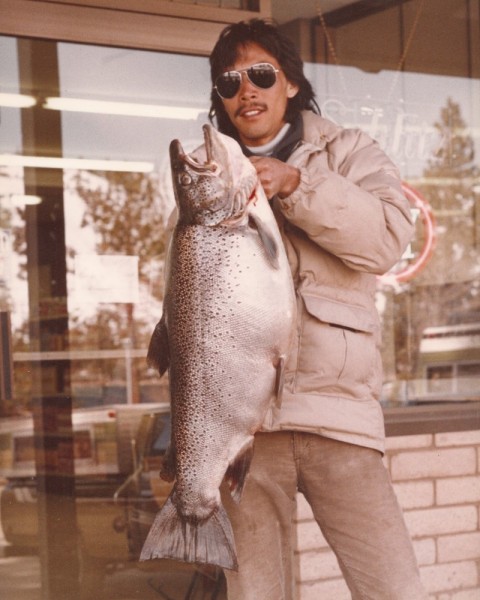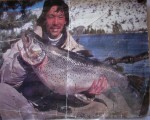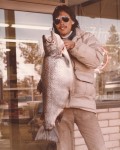
Jon Minami with the 1983 California State Record brown trout. One of my favorite big browns!
Click to view image


Introduction
The turn-off to the Lower Twin Lake in Bridgeport, California was still another 20 miles ahead, as we sped
northward on Highway 395. It was approximately seven hours since departing the Los Angeles area and
the closer we got - the more difficult time containing my excitement.
This journey initially began during a trip to the Eastern Sierras in the late 1970’s. After latching onto a big
hook-jaw that eventually shook itself off the hook, after a gut wrenching 10 minute battle- I was hooked
and the experience led me on mission. After returning home, I remember reading every book and article
that I could find on the Brown Trout. Some of the materials included interesting research studies that I had
found during a visit to the library at the California Department of Fish and Game in Long Beach, CA.
My interest in fishing began at an early age- growing up near the Pacific Ocean. Excursions to the Redondo
Beach harbor to catch Pacific Bonito on light tackle always brought fond memories that kindled a deep
seeded passion for the sport. Later- employment within the tackle industry provided unique opportunities
to witness cutting edge technologies. The exposure to rod and reel design became extremely beneficial in
building a specialized arsenal of fishing equipment that I could employ for any challenge. Technological
advancements for the freshwater bass fisherman also captivated me and led me to the famous big bass
reservoirs of Southern California. This background information is important, because herein lies some of
the ingredients for success.
I feel it’s important to understand the behavioral patterns of your prey- how they relate to structure, react to
changes in the environment and water temperatures, currents, feeding habits etc. An understanding of lake
structure is also vital.
The Eastern Sierra Opener - 1983
The winter months had been especially harsh, leaving many of the lakes on the Eastern High Sierras slopes,
frozen solid and unable to open in time for the 1983 trout season. I had already postponed my trip by a
week- before learning that the ice on the Lower Twin had been broken open just days prior to the opener.
A blustery wind had helped to break up the ice and clearing enough of the lake in time for opening day.
Unfortunately, I was forced to wait it out until the following week.
Our pre-discussed game plan was to motor directly to the upper end of the Lower Twin and start on the
bank opposite the main road. Past experience told us the majority of the anglers would put out their trolling
lines soon after leaving the marina- so starting at the upper end of the lake would provide us a window of
undisturbed fishing time, before the rest of the boats caught up and ‘churned up’ the waters. The location
we decided to start was an area often referred as ‘Sheriffs Point’ by locals. Schools of Kokanee Salmon
often gathered in the early morning (and sometimes evenings), just off the deeper edge, before moving off
the point. I had also metered several nice Browns suspended off deeper water during previous trips, which
helped to bolster my confidence in the area. The underwater topography consisted of a slight narrow ‘shelf’
that gradually sloped into deeper water. Just to the inside of Sheriffs Point was a tiny creek outlet (now
dry) and leading into a shallow cove. It’s important to realize that the Twin Lakes, although a majestic gem
with the Sawtooth Mountain peaks glaring down from the southwest- the lake lacks the normal bottom
structure found in other Sierra lakes. Simply put- you won’t find areas covered with underwater boulders
and submerged logs scattered across the lake bottom or a gently sloping point of granite rock protruding
into the lake. I’ve always trusted my Lowrance X-15 to serve as my underwater eyes and having ‘metered’
virtually every foot around the edge of the lake- I arrived at one conclusion.....acknowledging even the
most subtle of change in the bottom structure in a lake such as the Lower Twin can hold an important role.
I witnessed this during a late fall trip to Bridgeport Lake, which produced nine healthy browns. California
suffered severe drought conditions from the mid 80’s to early 90’s. When the lake levels dropped- the
shoreline fisherman followed, virtually carving a ‘stair step’ type effect along the lakes edge near the dam
area. When the drought conditions eased and the water levels rose back- the ‘stair step’ was covered by
8-10 feet of water and became a Brown Trout highway. The absolute most important key element was
cranking the lure parallel to the shoreline and over the top of the stair step- rather than throwing straight
out. This is how acknowledging and working a subtlety in the lake structure can work to your advantage.
The ride to the upper end seemed endless- but we finally put our lines out right at legal fishing time. The
morning air was freezing cold and a light breeze slightly broke the lake surface. We had spotted a nice
Brown ‘fining’ the surface in the area the day before and I made a decision to start trolling in an easterly
direction. Now here’s a most important piece of information. Remember that the lake had been frozen
all winter and had just begun to thaw- so water temperatures were barely above 42 degree Fahrenheit.
Incorporating this information into our game plan- we knew the fish would be lethargic and a ‘painfully’
slow trolling speed was an absolute. My skiff was equipped with a 9.9 hp Honda outboard, which had been
modified at the factory to better handle extreme cold weather conditions without ‘sputtering’ out. We made
our first initial pass across Sheriffs Point with the lures at 10-15 feet. Everything felt just right and the
leading edge of the crowd was still half way down the lake. The first run produced no bites so I swung the
boat around to make another methodical pass.
When she initially took the Rapala 18RT (tied onto 8lb. line)- I first only noticed the rod tip slowly
flexing, as if snagged on a tree branch. In my head- I knew we were trolling over 20 feet of water and my
lure was positioned at 12-15 ft. below the surface. In the slightest of moments- I felt my rod tip ever so
lightly ‘quiver’ and only then did I realize that it wasn’t a snag. She initially shook her head a couple of
times before heading into deeper water. Since there was little breeze that morning- keeping her in front
of me was relatively easy. Approximately 10 minutes had passed before I caught my first glimpse of her-
violently shaking her head just beneath the boat. Five feet below the boat- she tried to roll. I knew at that
moment- I needed to change the rod tip angle and apply as much pressure to keep her head from turning.
Fortunately, the line held- but my nerves didn’t after we gently laid her on the bottom of the boat. I realized
at that moment my dream had been reached.
Hard work, persistence, developing and executing a game plan are things that contributed to reaching my
dream. We also have positive influences that we look up to and idolize because of their successes. I’ve
always modeled myself after Bob Bringhurst and Jim Bringhurst- because of their integrity and the fact
that they always fished extra hard. I’ll most especially remember the kind words of encouragement Bob
Bringhust offered me after a disappointing day.
In Closing
Life has its challenges. Mine came after losing all out personal belongings in a residential fire- including
my fishing tackle, fishing logs and photos. One thing that wasn’t lost is the fond memory. I’m honored to
share these memories with you and truly wish you all the very best.